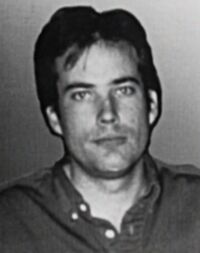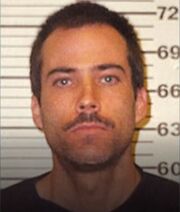
Eric Rudolph
Real Name: Eric Robert Rudolph
Aliases: None known
Wanted For: Murder, Attempted Murder, Terrorism
Missing Since: July 1998
Case[]
Details: On July 27, 1996, at Centennial Park, Fallon Stubbs and her forty-four-year-old mother, Alice Hawthorne, were visiting Atlanta, Georgia, celebrating her fourteenth birthday. Just before 1:20am, they stopped to take a photo when a bomb shattered the Olympic Games, killing Alice and injuring hundreds. A security guard named Richard Jewell soon became the prime suspect, but he was soon cleared in the case. A task force of several state and federal investigators was created.
Within the next seven months, two more bombings would occur in Atlanta: one at an abortion clinic on January 16, 1997, and another at a lesbian bar on February 21, 1997, injuring dozens. Investigators discovered that the bomber was planting a second device apparently designed to injure police officers and rescue personnel that responded to the first bomb. FBI and ATF technicians recreated the bombings and found that all three were linked through forensic evidence.
After the third bombing, letters were left by the "Army of God", an unknown terrorist group who claimed responsibility for the three bombings. The writer mentioned certain details about the bombs that had not been released to the public. The writer targeted homosexuals, abortionists, and members of the federal government. An FBI profiler analyzed the letters and believed that the bomber's true target was law enforcement.
On January 29, 1998, abortion clinic nurse Emily Lyons arrived early for work. She and off-duty police officer and security guard Robert Sanderson were walking to the entrance of the clinic in Birmingham, Alabama, when she noticed an overturned flowerpot that looked out of place. When Robert tried to move it, it exploded. Shrapnel killed him and seriously injured Emily, who had several screws and nails in 90% of her body.
Investigators realized that the bomber had finally achieved his goal: murdering a law enforcement officer; but this time, forensics revealed that the bomb was detonated by a remote control, meaning that the bomber was nearby. A witness came forward claiming that he noticed a mysterious man leave the scene of the bombing, take off a wig, and drive away in a pick-up truck. The witness wrote down his license plate which was traced to thirty-one-year-old Eric Rudolph. An arrest warrant was placed for him in February 1998.
Eric resided in western North Carolina. A swat team raided his trailer. The air conditioner was still running and there was food on the table; they had missed him by just a few minutes. When he was a teenager, he told friends that if he ever got in trouble with the law, he would disappear into the mountains. Several hundred law enforcement officers searched through Nantahala National Forest after his truck was found abandoned nearby. However, no other trace of him was found.
Investigators learned that Eric had been raised in a family of white supremacists and separatists. He had also served in the US Army and was an experienced outdoors-man and survivalist. His former sister-in-law recalled that he was a hateful person. He always talked about negative things, like hatred against authority, gun laws, and the government.
The last sighting of Eric was in July 1998 by a close friend, George Nordmann, who owned a grocery store and lived in a remote mountain cabin. He approached George about food, but he decided to not help him. Just two nights later, the Nordmanns were raided; several pounds of food and a truck were stolen, most likely by Eric. He remains on the FBI's Most Wanted List. He has been charged with the three bombings in Atlanta and bombing in Birmingham, along with the murders of Alice Hawthorne and Robert Sanderson.
Extra Notes:
- This case first aired on the June 12, 2002 episode.
- The possible connection between the then-unsolved Atlanta bombings and a series of bombings in Spokane was featured on the May 16, 1997 episode.
- The case was previously profiled on America’s Most Wanted during the investigation and later documented on episodes of FBI: Criminal Pursuit and 1990s: The Deadliest Decade after Rudolph was arrested.

Rudolph after his 2003 arrest
Results: Captured. In May 2003, the police picked up a homeless man going through the trash in North Carolina and brought him to the police station. They noticed that he seemed to be identical to the Eric Rudolph wanted poster. They soon confirmed his identity while in custody. He had been living off scraps and leftovers from the trash.
Eric was charged with two counts of murder, and several counts of terrorism. Along with his truck being seen fleeing the last bombing, investigators had other evidence that connected him to the bombings. At least fifteen friends and acquaintances of his identified his voice as being the caller who contacted 911 thirty minutes before the Centennial Park Bombing. His handwriting and punctuation was similar to that found in the four letters left by "Army of God." Identical brown cotton fibers were found on the Centennial Park bomb debris, the Army of God Letters, and his truck. Five shell casings found in his storage locker contained power chemically consistent with debris from the Centennial Park bomb. Nails found in it were similar to ones used in the later bombings.
A sibling of Eric's also claimed that, prior to the Centennial Park Bombing, he had mentioned that the Olympics would be the "prime target" for a terrorist attack. A specific technique used to carry the backpack that held the Centennial Park bomb was taught and commonly used at an Army school that he attended. Finally, a Tennessee gun dealer identified him as the man who bought 50 pounds of smokeless powder several years before the bombings. Investigators said that powder was connected to the Centennial Park bomb.
Faced with the evidence against him, Eric entered a plea bargain in August 2005. He was sentenced to four life terms in prison in exchange for telling authorities where he hid several explosives in the North Carolina wilderness.
Links:
- Eric Rudolph on Unsolved.com
- Eric Rudolph on Wikipedia
- Eric Rudolph on the FBI Website
- Woman Who 'Lost Her Life While Celebrating the Human Spirit' - July 30, 1996
- Bomb Kills Guard at an Alabama Abortion Clinic - January 30, 1998
- 'Army of God' letters claim responsibility for clinic bombing - February 2, 1998
- Sources: Evidence links Birmingham, Atlanta bombings - February 27, 1998
- Search for Bombing Suspect Resumes - July 12, 1999
- Some Evidence Against Eric Rudolph - May 30, 2003
- Olympic Bomb Suspect Rudolph Caught - May 31, 2003
- Suspect in '96 Olympic Bombing And 3 Other Attacks Is Caught - June 1, 2003
- Rudolph evidence revealed - June 7, 2003
- Rudolph reveals motives - April 13, 2005
- Olympic Park bomber Eric Rudolph agrees to plead guilty - November 13, 2009
- Eric Robert Rudolph - Fast Facts - December 6, 2012
- The Summer Olympic Bombing in Atlanta: 20th Anniversary - July 26, 2016
- Alice Hawthorne on Find a Grave


